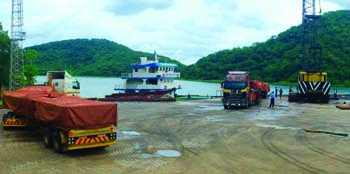
•TRUCKS loaded with goods at Mpulungu Harbour in Northern Province en-route to the Great Lakes region yesterday. Picture by MULUMBA LWATULA/IDC
By MAIMBOLWA MULIKELELA in Mpulungu – MPULUNGU Harbour Corporation Limited, a subsidiary of the Industrial Development Corporation (IDC) has projected to facilitate the movement of more than 10,000 tonnes of exports into the Great Lakes Region this year. Mpulungu harbour general manager Davies Kaluba said the port estimates to handle exports into the Great Lakes Region of more than 10,000 tonnes by the end of 2016. Mr Kaluba said Mpulungu Harbour operates Zambia’s water port and it was able to achieve the projected trade volume by fully utilising the port. He said trade in 2015 was depressed as a result of the problems in Burundi which impacted negatively on the export figures especially from April to September. Mr Kaluba said trade however started to rebound in October and export volumes began to pick and that trade was in the region of 3,500 tonnes to 4,500 tonnes throughout the year. He said by November 2015 trade volumes increased to 6,000 tonnes and in December the figures moved up to 7,400 tonnes while in January, 2016, the trade volumes stood at 5,800 tonnes. Mr Kaluba said this when IDC officials conducted a tour to assess the current operations of Mpulungu Harbour. “What is sustaining the port are the sugar exports going into Burundi, the Democratic Republic of Congo (DRC) and Rwanda. Zambia Sugar services those three countries,” Mr Kaluba said. He said the harbour also exported some steel products and seed from Seedco and other seed companies destined for Rwanda. Mr Kaluba said in November and December last year the harbour exported some maize into the Great Lakes region. He said they were working hard to ensure that they bring back on stream the exports of cement now that local demand was sustained. Mr Kaluba said with the coming of Dangote Cement on market with who they were in discussion to start using the port for exports of cement into the Great Lakes region to ensure balance. IDC executive director for operation Paul Siame said Mpulungu Harbour had a lot of potential to increase the volumes of exports out of Zambia. Mr Siame said there was need to support the whole value chain in terms of logistics such as water vessels, railway and road transportation in order to realise increased revenue from the operations of the harbour. This would not only increase the amount of goods that are exported through the harbour but would also create more jobs for Zambians. Mr Siame said Mpulungu port was the only outlet to the Great Lakes region and that South Africa has had to use road or sea transport through Tanzania to reach Burundi and Rwanda when the harbour was more ideal.






